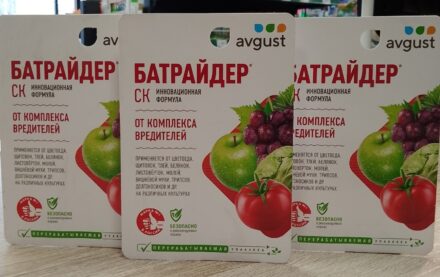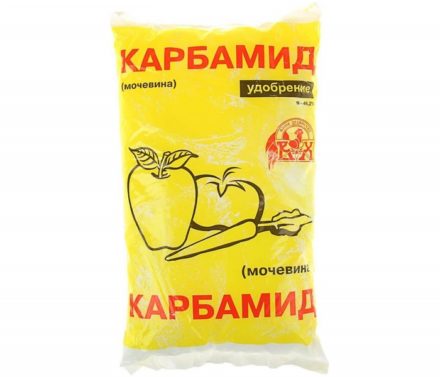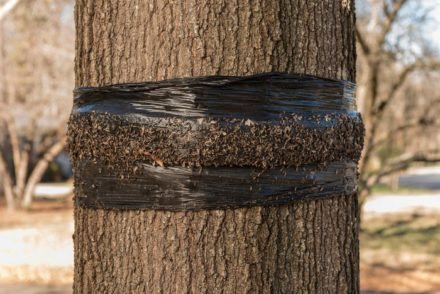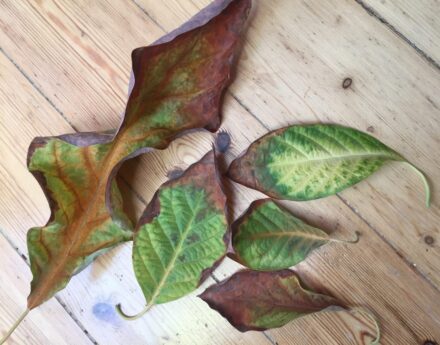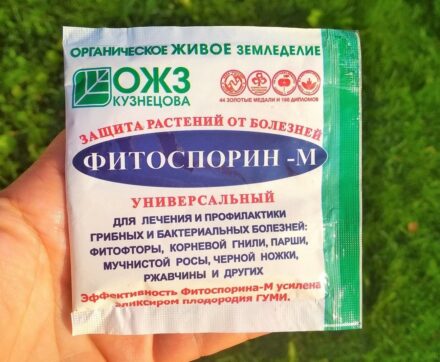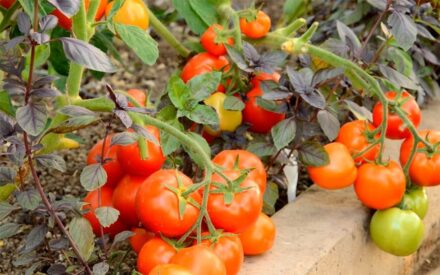Teppeki insecticide is one of the most effective means for combating harmful insects. Insecticides are special chemicals that destroy not only pests, but also their larvae. Even if you are a very attentive and conscientious gardener who follows all the rules for caring for plants, you are still not immune from the appearance of pests. Their colonies reproduce very quickly. If you do not treat the plants with an insecticide in time, you will not have to wait for the harvest.
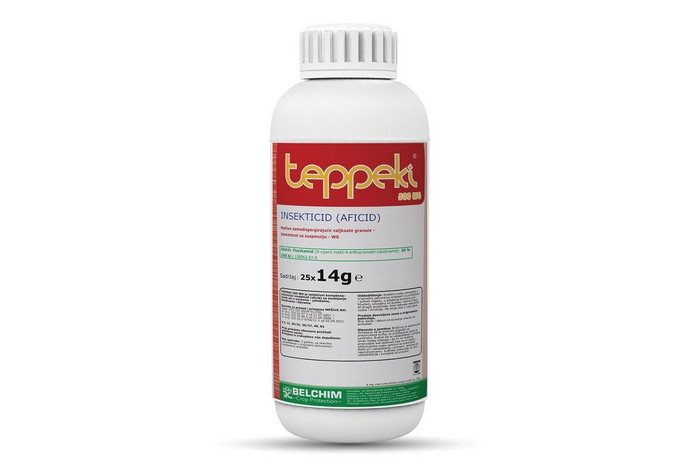
- Description
- Purpose
- Composition of Teppeki insecticide
- Release forms
- Mechanism of action
- Hazard Class
- On what crops is it used?
- From what pests
- Instructions for use
- How to divorce
- Consumption rate
- Processing times
- Validity
- Insect treatment rules
- From whitefly
- From thrips
- From mealybug
- From spider mites
- From aphids
- From scale insects
- Features of use for different plants
- Advantages and disadvantages
- Compatibility with other drugs
- Analogs
- Precautionary measures
- For man
- For the environment
- Methods of neutralization
- Storage rules
- Consumer Reviews
Description
Teppeki was developed by Belgian scientists. Its manufacturer is the well-known company ISK Biosciences Europe N.V. It is registered in many countries around the world. The popularity of the Teppeki insecticide is due to the speed of achieving the effect and the wide range of effects.
It destroys all types of aphids and other sucking insects. In addition, it affects pests that are not on the plant and controls their number outside the area of action. At the same time, Teppeki is absolutely safe for the plant itself.
In our country, it has undergone all the necessary studies. It is widely used in agriculture. The Teppeki insecticide is recommended for use by Rosselkhoznadzor.
Purpose
The use of Teppeki is recommended for the destruction of pests of the order Homoptera, as well as for controlling the number of other pests .
Composition of the Teppeki insecticide
The Teppeki insecticide has a high concentration. It is not used in its pure form. Its main substance is flonicamid, which is responsible for the anti-feeding effect. 1 kg of Teppeki insecticide contains 500 g of flonicamid.
To treat plants, use a solution prepared independently, according to the instructions.
Release forms
The Teppeki insecticide is available in the form of water-dispersible granules. It is packaged in plastic containers of various weights at retail outlets. It can be dispensed for single use.
Mechanism of action
The mechanism of action of the Teppeki insecticide is contact-systemic, within half an hour after spraying, the active substance - flonicamid is actively absorbed by plant cells. Parasitic insects use plant juice for nutrition, which after spraying contains flonicamid, together with food they receive a lethal dose of the drug. Their nervous system is destroyed.They stop destroying the plant, although they continue to be on it. And over the next five days they die, unable to eat.
Hazard Class
According to the chemical hazard scale, Teppeki insecticide is assigned class 3. This group includes substances with a medium level of danger. To carry out treatment of plants, the skin, eyes and respiratory organs should be protected. If this requirement is not met, mild toxic poisoning may result. It is not recommended to spray plants in a confined space.
This product is equally dangerous for domestic animals and bees.
From an environmental point of view, the concentrated insecticide Teppeki is dangerous. The aqueous solution prepared for spraying the plant does not pose a threat.
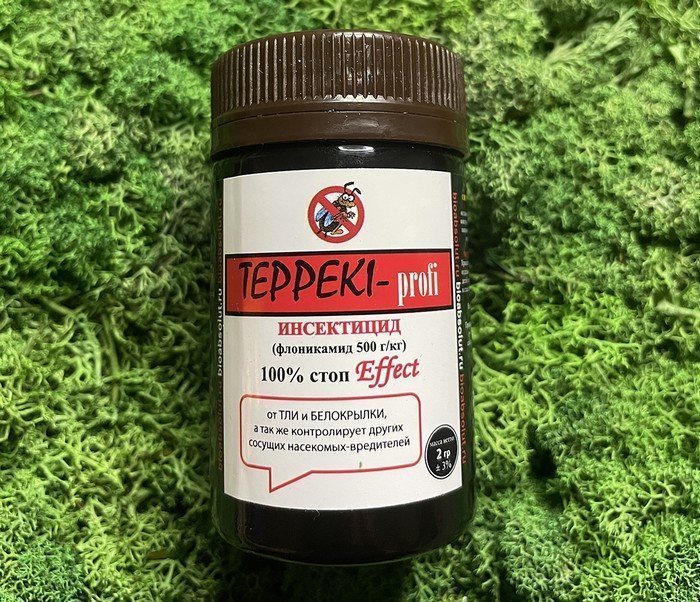
On what crops is it used?
The chemical is equally effective when used on various crops:
- vegetables - potatoes, all varieties of cabbage, tomatoes, cucumbers, bell peppers, eggplants, zucchini, squash, onions, garlic, beets, carrots, green peas and beans;
- fruits and berries - apple, pear, all types of plums, cherries, sweet cherries, apricots, peach, cherry plum, grapes, strawberries, raspberries, wild strawberries, currants, blackberries, honeysuckle and gooseberries;
- flower crops - roses, peonies, asters, daffodils, irises, tulips, lilies, dahlias;
- all types of indoor plants;
- ornamental plants - lilac, barberry, derain, viburnum, spirea, bladderwort, hosta and heuchera;
- melons - pumpkin, melon, watermelon;
- citrus fruits – lemon, orange, tangerine, kumquat;
- exotic crops - avocado, pineapple, lychee, langan.
From what pests
The product acts differently on each type of parasite.
The following are subject to complete destruction:
- all types of aphids including leaf, gall, beet, bean, melon, cucumber, cabbage, carrot, rose, potato, greenhouse, peach, hairy, mealy;
- whitefly,
- psyllid;
- all types of mites, including spider mites;
- all types of thrips.
The Teppeki insecticide is no less effective on other parasites, but the nature of the effect will be different. He does not kill them, but noticeably controls their numbers, i.e. does not allow reproduction.
Instructions for use
To avoid mistakes when using Teppeki insecticide, as well as to obtain the desired result, you must follow all points of the instructions that come with the drug. If you violate the rules of dosage, frequency of spraying or inappropriate use, you may not get the long-awaited harvest, and even worse, you may be left without a plant.
How to divorce
To use Teppeki insecticide, it is necessary to prepare a working solution. To get the desired effect, it is very important to do this according to the instructions and follow the consumption rates of the product.
The spray solution must be prepared on the day of use and used immediately.
The required amount of granules (their weight is important) of the Teppeki insecticide is dissolved in a small amount of water. The granules do not dissolve well, so the solution must be shaken or constantly stirred until completely dissolved.
After the granules have completely dissolved, the solution is adjusted to the required amount by diluting with water.
It is necessary to prepare the working fluid in an open room, or better yet, in the fresh air.
Consumption rate
The consumption rate of Teppeki insecticide granules per amount of water varies depending on the plant crop.
1 g of the drug is used as the basis for calculations. This is the amount that destroys 100% of all pests. The following dosage is used for different crops:
| Culture | Consumption rate of the drug / required volume of water | Working fluid flow |
| Potato | 1 g/1.5-3 l | 200-500 l/ha |
| Apple, pear, peach | 1 g/5-7 l | 500 l/ha |
| Winter wheat, rye | 1 g/1.5-4 l | 200-500 l/ha |
| Flower crops | 1 g/4-8 l | 200-400 l/ha |
| Berry bushes | 1 g/5-8 l | 200 l/ha |
| Melons | 1 g/4-6 l | 200-300 l/ha |
| Vegetables | 1 g/5-7 l | 300-400 g/ha |
Consumption rates depend on the area being sprayed and how the sprayer is configured.
Processing times
Teppeki insecticide begins to be used with the first warming, when parasite larvae appear. Plants must be treated during the growing season. The exception is vegetable beds and berry bushes. They need to be sprayed at the initial stage of the growing season. But no more than three times a season. Repeated treatment should be done no earlier than 7-10 days.
The use of Teppeki insecticide during flowering and fruiting is permitted. For fruit and vegetable crops, spraying is carried out in early spring, before the first leaves appear, and a second time is applied immediately after flowering has ended.
The last spraying should be no later than 21 days before the start of harvesting so that the active substance is neutralized.
It is best to apply Teppeki insecticide in the evening, after watering has ended, or in the early morning. In addition, the weather on the day of treatment should be dry and windless.
Validity
The effect of the product on the plant lasts for 14-30 days. If you sprayed it during the period of fruit ripening, then you can eat them after 55 days.
Insect treatment rules
Various pests parasitize garden and flower crops. For each type of insect, a special use of Teppeki insecticide has been developed. This is due to the required concentration of the main substance of the insecticide to destroy a certain type of pest.
From whitefly
The whitefly is a very secretive insect, which attacks indoor, garden and greenhouse plants. You can detect it without a special device - you can’t hide its white wings. But it is located at the bottom of the leaf plate, so it is not always possible to quickly determine its presence. If the leaves of a plant begin to dry out and fall off, it means it has been attacked by a pest. Flower buds become deformed. In addition to destruction, this parasite is a carrier of diseases such as curl, jaundice and chlorosis. Among flower crops, he prefers fuchsia, balsam, begonia, and geranium. In the greenhouse it attacks cucumbers, tomatoes and bell peppers, and does not hesitate to feast on zucchini and eggplant.
To combat whiteflies, you need to prepare a solution consisting of 1 g of Teppeki insecticide and 7 liters of water. The amount of water depends on the plant crop. One spraying is quite enough to completely destroy the pest. However, if re-treatment is required, it must be carried out only after a week.
From thrips
Thrips are small winged insects, slightly more than 2 mm in size. Their larvae appear in stumps, under the bark of trees, in lichens and moss.On the plant, they feel great in flowers, buds and on leaves. They are resistant to cold climates. In an apartment or greenhouse, they actively reproduce all year round. They feed on plant juice, as well as pollen and nectar.
The higher the temperature, the faster the pest eggs mature. The main indicator of the presence of thrips is the appearance of dark spots on the trunk and leaves of the plant. And also the drying of flower buds for no apparent reason.
To get rid of these insects, you should prepare a solution with a dosage of 0.5 g of Teppeki insecticide per 1 liter of water. The affected plant must be treated three times every 7 days. It is important to take into account the period of plant vegetation and fruiting.
From mealybugs
The insect is closely related to the scale insect. It is an unarmored scaly representative of pests. A warm and humid environment is favorable for their habitation. It tolerates temperature changes perfectly. As a rule, it affects seedlings on the windowsill and home ornamental plants. Its attack provokes further death of the affected areas of the plant. It reproduces quickly at warm temperatures. It feeds on plant sap.
The first sign of the presence of this parasite is yellowed and fallen leaves. If the watering conditions were met, then this behavior directly indicates the presence of a mealybug.
To destroy it, it is necessary to treat all the plants present in one area, if this is not done and you concentrate only on the affected plant, then the pest will appear again on untreated crops.
To completely exterminate the mealybug, it is necessary to use several preparations.Processing takes place in a comprehensive manner. The plant is not sprayed with product solutions, but the soil is watered. In this case, the dosage of the drug increases 5 times.
The plant should be processed according to this scheme:
- The first time it is necessary to water the soil with Confidor solution. To do this, 1 g of the product is diluted in 1 liter of water. Used together with a solution of the drug "Apluad", which is obtained by diluting 0.5 g of the product per 1 liter of water. Both solutions must be prepared separately from each other. Liquids already prepared for irrigation should be mixed;
- The second time the soil is treated with the Teppeki insecticide. To prepare the solution, use the following dosage - 1 g per 1 liter of water. It is necessary to water the plant a week after the first treatment;
- 21 days after the second watering, the plant should be watered again with the prepared solution of the drug “Confidor” or “Aktar”. Dosage of the product is 1 g per 1 liter of water.
If you have other insecticides available, then an important point for using them should be a different active ingredient.
From spider mites
This is a pest from the order of arachnids, approximately the size of a flea. It feeds on plant sap. Lives on the inside of leaves, forming a thin web there. Willingly feeds on indoor plants, grapes, and settles on cucumbers and tomatoes. Does not disdain berry bushes and fruit trees. The main reason for its appearance is considered to be dry climate and high air temperature. This is the most comfortable environment for its reproduction.
The result of its parasitic work is the death of the plant.
The first sign of a pest is a change in leaf color. They become marbled. Their tips dry out, then the leaf turns completely yellow and falls off.Mites can be identified by the presence of small red dots on the leaves and trunk of the plant.
To destroy it, you need to prepare a solution of 1 g of Teppeka and 1 liter of water. The plant must be sprayed three times, at intervals of 21 days.
From aphids
Aphids are small parasites that feed on plant sap. For its reproduction, a dry and warm climate is required. If the warm season is rich in rain, then there will be almost no rain. The first sign of the presence of a pest is curled leaves, swellings on the leaves of a burgundy or yellow hue.
To get rid of this pest, you should prepare a solution of 2 g of Teppeki insecticide per 10 liters of water. Treat the affected plants with this liquid. In total, you need to do 2-3 treatments with an interval of 7 days.
From scale insects
A small insect of the order Hemiptera. Her body is made up of armor that protects her from chemicals. Scale insects happily settle on indoor plants and garden crops. It feeds on the sap of the plant. The first sign of its presence is the blackened and fallen lower leaves of the plant. It can also be recognized by the presence of brown tubercles on the inside of the leaves and the trunk.
To destroy it, it is necessary to prepare a solution of Teppeki insecticide with a dosage of 1 g per 8 liters. This solution must be sprayed on plants. To water the soil, 1 g of the product is diluted with 4 liters of water.
Only with double exposure to the insecticide can you get rid of the scale insect.
Features of use for different plants
For each crop, the product has specific application features:
- flower plants are treated with a solution of 1 g/8 l;
- fruit trees are treated with a solution of 1 g/7 l of water.It is important to remember that treatment must be carried out in early spring, during the appearance of the first leaves and after harvesting;
- potatoes are sprayed with a solution of 1 g/3 l of water. You can eat the tubers after 1 month. It is not recommended to dig them up earlier;
- cucumbers, tomatoes and other vegetables should be treated with a solution consisting of 1 g/7 l. At the same time, it is important to carry out the treatment at an early stage of crop growth, because the fruits of these plants ripen quickly, and they cannot be eaten for a month after treatment;
- indoor indoor plants must be treated with a liquid consisting of 1 g/8 l of water. It is impossible to process indoor plants in a closed space. To do this, take them out onto the balcony or other open surface. Treatment is carried out three times with an interval of 7-10 days.
Advantages and disadvantages
The effectiveness of the drug is due to a number of advantages:
- the destruction of pests begins immediately after applying the product;
- similar effects on insects that were outside the treatment area;
- long period of exposure;
- lack of addiction to the drug in pests;
- it is possible to combine the product with other insecticides;
- not dangerous to beneficial insects, poses little danger to bees;
- the direct effect of the Teppeki insecticide begins within 30 minutes after treatment;
- the action of the product allows you to control the proliferation of other pests;
- environmentally friendly;
- destroys all known species of aphids and sucking parasites.
Among the disadvantages, experienced gardeners note:
- Possibility of processing only three times per season.
Compatibility with other drugs
The insecticide Teppeki is compatible with other preparations, provided that they do not contain alkali and copper. If the composition of the product is not indicated in the instructions for use, you should check it yourself. To do this, prepare high-concentration working solutions and mix them in plastic or glass containers. If no signs of chemical reactions are observed (color change of the solution, precipitation, temperature increase, etc.), then the preparations can be used together in complex treatment.
Analogues
Manufacturers strive to provide customers with various analogues of the insecticide Teppeki. One of the newest is the Japanese drug Urara. Its action is similar to the drug Teppeki. Another well-known analogue is the insecticide Voliam Flexi. Many insecticides have properties similar to Teppeki. However, there is still a difference. Only to the insecticide Teppeki, pests do not develop immunity and addiction.
Precautions
Hazard class 3 has been established for this chemical. In accordance with safety regulations, it is necessary to use protective equipment when using this product. To do this, cover the skin, put on plastic glasses and gloves. In addition, it is necessary to protect the respiratory system.
For humans
The concentrated solution of Teppeki insecticide is dangerous for humans. But working fluids that are prepared from a concentrated solution and water do not pose a great danger to humans. If you use the necessary protective equipment, poisoning is excluded.
For the environment
The product is absolutely safe for the environment.
Methods of neutralization
When carrying out work, observe the following rules of personal hygiene:
- upon completion of work, it is necessary to wash all containers for preparing and spraying the product;
- After completing the treatment, you should wash your hands thoroughly with soap;
- in case of accidental contact with the lungs, the victim should be taken to fresh air;
- In case of contact with skin, wash it with warm water and soap;
- In case of contact with eyes, rinse eyes with running warm water;
- If you feel dizzy and nauseous, you should consult a doctor.
Storage rules
To store Teppeki insecticide, you should choose hermetically sealed packaging. Permissible storage temperature is from +18°C to +22°C. The shelf life of the drug is 3 years from the date of manufacture.
Consumer Reviews
The best information about the effectiveness of Teppeki insecticide is provided by reviews from those who have already used it.
Valentin Rozhkov, Novgorod.
“Excellent drug. I sprayed cucumbers against whiteflies. The effect was already on the second day. I sprayed again and the whitefly disappeared completely.”
Karina Barbus, St. Petersburg.
“Usually I used inexpensive products for processing. But this year they couldn’t cope with the aphid invasion. I ordered Teppeki insecticide via the Internet. The price, of course, bites. But the effect is amazing. The aphids have completely disappeared. Throughout the season, I treated it three times according to the instructions. The last one is 30 days before harvest. A truly effective remedy. And if you recalculate the amount that you spent on inexpensive drugs, it turned out to be economical. From now on I will only use it."
Timur Savchenko, Kazan.
“I’ve only been using this insecticide lately. Teppeki copes well with pests. I only process it once.I dilute the product according to the instructions, but sometimes I reduce the dose, depending on the crop. He has no equal in terms of efficiency.”
Suzanna Nyrova, Stavropol.
“For my area I use only 2 g of the drug. For the whitefly, this is the most terrible enemy. The product destroys it completely. If you buy by weight, the price is quite reasonable, it turns out almost the same as other products. After treatment, the whitefly disappears and I don’t see it again for the entire season. Other pests also try not to settle in my garden. This is the best drug to combat them.”
Vladimir Turtsev, Krasnodar.
“I have been breeding houseplants for a long time; I used various insecticides in the fight against spider mites and scale insects. After I tried Teppeki, all the others ceased to exist for me. If you do everything correctly, according to the instructions, the effect is amazing. I use a loggia for spraying; there is no particular danger to a pet (I have a dog). The effect is noticeable, parasites multiply to a lesser extent, this allows them to be destroyed forever. After treatment with the Teppeki insecticide, they no longer appear. In my case, two treatments were enough.”
Christina Reismann, Kursk.
“To treat my summer cottage I use only Teppeki insecticide. For five acres you need 3 g of the drug. I buy only the required quantity. It is quite enough for spraying all crops. I do the first treatment in the spring, until the first leaves. Previously I processed it three times, now one is enough. The effect is amazing, although it is noticeable only after three days. The price of the drug is acceptable, considering its effectiveness.”
Teppeki insecticide has repeatedly proven its uniqueness and effectiveness.To get the desired result, you must follow the dosage and processing rules, according to the instructions for use. To protect yourself, you should use personal protective equipment. And then everything will be in order in your garden!


